演讲翻译的批评赏析
- 格式:pptx
- 大小:549.86 KB
- 文档页数:47
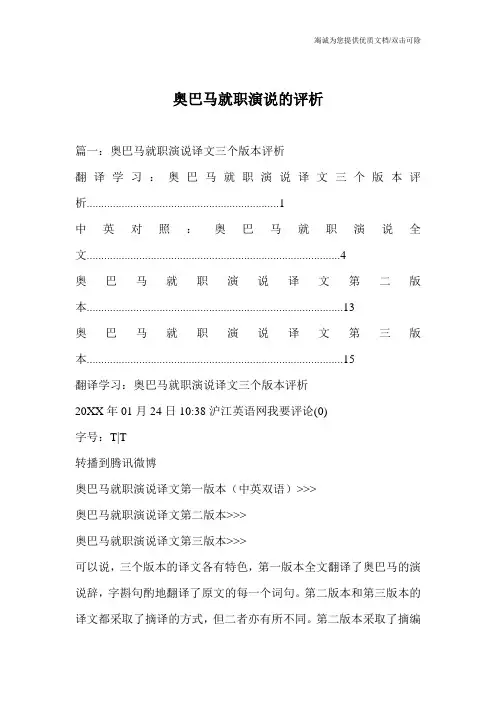
奥巴马就职演说的评析篇一:奥巴马就职演说译文三个版本评析翻译学习:奥巴马就职演说译文三个版本评析 (1)中英对照:奥巴马就职演说全文 (4)奥巴马就职演说译文第二版本 (13)奥巴马就职演说译文第三版本 (15)翻译学习:奥巴马就职演说译文三个版本评析20XX年01月24日10:38沪江英语网我要评论(0)字号:T|T转播到腾讯微博奥巴马就职演说译文第一版本(中英双语)>>>奥巴马就职演说译文第二版本>>>奥巴马就职演说译文第三版本>>>可以说,三个版本的译文各有特色,第一版本全文翻译了奥巴马的演说辞,字斟句酌地翻译了原文的每一个词句。
第二版本和第三版本的译文都采取了摘译的方式,但二者亦有所不同。
第二版本采取了摘编的方式,对奥巴马演讲的内容进行分门别类,分为美国建国精神、经济、医疗、气候、国防、民生等方面,选译了其中最重要的一些内容。
而第三版本的译文则采取了新闻报道的方式,通过视角转换使译者介入到译文之中,文中使用了―奥巴马称‖等叙事引导词。
因为第一版本的译文是全译,所以可以全面反映奥巴马演讲的内容和风貌。
该译文总体上能够把握美国总统演讲的特点,采用了非常朴素的语言,以尽量贴近原义的方式译出了原文的意思。
例如:1.Thepatriotsof1776didnotfighttoreplacethetyrannyofakingwiththeprivile gesofafewortheruleofamob.1776年,美国的爱国先驱们不是只为了推翻国王的暴政而战,也不是为赢得少数人的特权,建立暴民的统治。
该版本的译文也注意到了演说辞中的系统隐喻journey在全文所起的统领作用,对诸多其他隐喻也能够译出其隐含的意思,在排比的处理上注意到了用词的变化,在用典的处理上,使用了解释性翻译手段,帮助读者了解文化背景。
例如:2.we,thepeople,declaretodaythatthemostevidentoftruths–thatallofusarecreatedequal–isthestarthatguidesusstill;justasitguidedour forebearsthroughSenecaFalls,andSelma,andStonewall;justasitguidedalltho semenandwomen,sungandunsung,wholeftfootprintsalongthisgreatmall,toh earapreachersaythatwecannotwalkalone;tohearaKingproclaimthatourindividualfreedomisinextricablyboundtothefreedomofeverysoulonEarth.我们,人民,今天昭示的最明白的事实是——我们所有人都是生而平等的,这是依然引领我们的恒星。
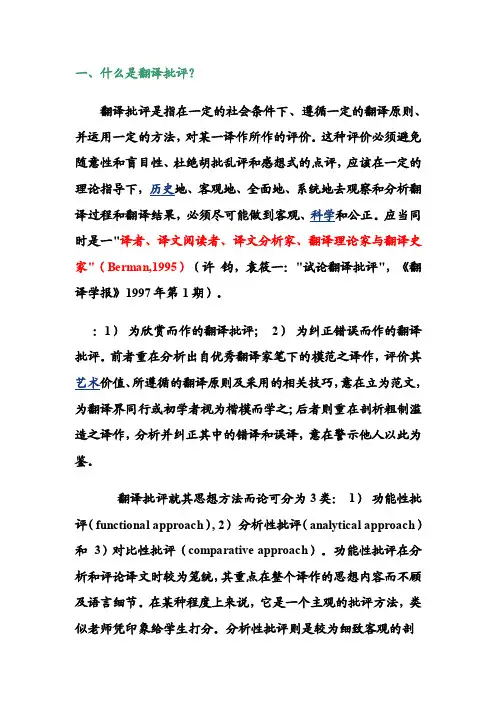
一、什么是翻译批评?翻译批评是指在一定的社会条件下、遵循一定的翻译原则、并运用一定的方法,对某一译作所作的评价。
这种评价必须避免随意性和盲目性、杜绝胡批乱评和感想式的点评,应该在一定的理论指导下,历史地、客观地、全面地、系统地去观察和分析翻译过程和翻译结果,必须尽可能做到客观、科学和公正。
应当同时是一"译者、译文阅读者、译文分析家、翻译理论家与翻译史家"(Berman,1995)(许钧,袁筱一:"试论翻译批评",《翻译学报》1997年第1期)。
:1)为欣赏而作的翻译批评;2)为纠正错误而作的翻译批评。
前者重在分析出自优秀翻译家笔下的模范之译作,评价其艺术价值、所遵循的翻译原则及采用的相关技巧,意在立为范文,为翻译界同行或初学者视为楷模而学之;后者则重在剖析粗制滥造之译作,分析并纠正其中的错译和误译,意在警示他人以此为鉴。
翻译批评就其思想方法而论可分为3类:1)功能性批评(functional approach), 2)分析性批评(analytical approach)和3)对比性批评(comparative approach)。
功能性批评在分析和评论译文时较为笼统,其重点在整个译作的思想内容而不顾及语言细节。
在某种程度上来说,它是一个主观的批评方法,类似老师凭印象给学生打分。
分析性批评则是较为细致客观的剖析,译文中的每一个词语、每一句话、每一语段和段落都会对照原文加以对比和分析,错误的译文被分门别类地挑出来加以评论,并提出改进意见;好的译文挑出来加以褒扬。
对比性批评是选择同一原作的若干种译文,同时采用译文与原文对比、译文与译文对比的方法找出各自的优劣之处。
好的加以褒奖,劣的予以批评。
翻译批评有助于克服翻译界存在的滥译、乱译等问题,因而对繁荣我国翻译事业有着不可低估的现实意义和深远的历史意义;翻译批评有助于纠正译作中出现的错误、改进不足,因而对提高译文的质量有着积极的作用;翻译批评还是联系翻译理论和翻译实践的重要桥梁,因为任何翻译理论的建立均有待于翻译实践的检验;反之,任何翻译实践都会自觉或不自觉地遵循一定的翻译理论。
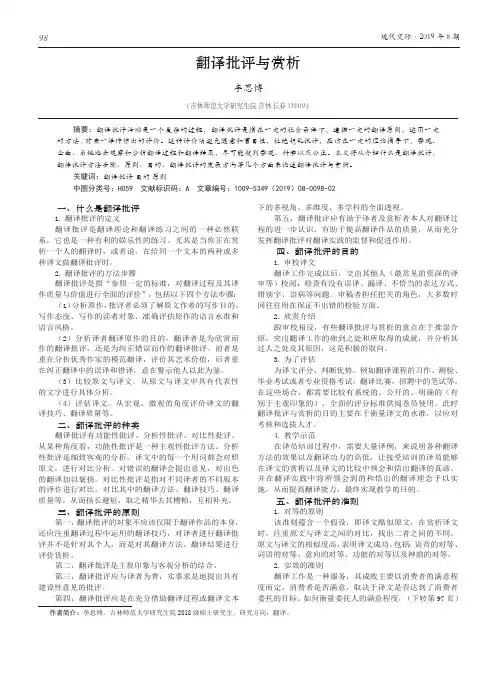
98现代交际·2019年8期作者简介:李思博,吉林师范大学研究生院2018级硕士研究生,研究方向:翻译。
翻译批评与赏析李思博(吉林师范大学研究生院 吉林 长春 130103)摘要:翻译批评活动是一个复杂的过程,翻译批评是指在一定的社会条件下,遵循一定的翻译原则,运用一定的方法,对某一译作作出的评价。
这种评价须避免随意和盲目性,杜绝胡乱批评,应该在一定的理论指导下,客观、全面、系统地去观察和分析翻译过程和翻译结果,尽可能做到客观、科学以及公正。
本文将从介绍什么是翻译批评,翻译批评方法步骤、原则、目的、翻译批评的发展方向等几个方面来论述翻译批评与赏析。
关键词:翻译批评 目的 原则中图分类号:H059 文献标识码:A 文章编号:1009-5349(2019)08-0098-02一、什么是翻译批评1.翻译批评的定义翻译批评是翻译理论和翻译练习之间的一种必然联系,它也是一种有利的娱乐性的练习。
尤其是当你正在赏析一个人的翻译时,或者说,在给同一个文本的两种或多种译文做翻译批评时。
2.翻译批评的方法步骤翻译批评是指“参照一定的标准,对翻译过程及其译作质量与价值进行全面的评价”,包括以下四个方法步骤:(1)分析原作,批评者必须了解原文作者的写作目的、写作态度、写作的读者对象、准确评估原作的语言水准和语言风格。
(2)分析译者翻译原作的目的,翻译者是为欣赏而作的翻译批评,还是为纠正错误而作的翻译批评。
前者是重在分析优秀作家的模范翻译,评价其艺术价值,后者重在纠正翻译中的误译和错译,意在警示他人以此为鉴。
(3)比较原文与译文。
从原文与译文中具有代表性的文字进行具体分析。
(4)评估译文。
从宏观、微观的角度评价译文的翻译技巧、翻译质量等。
二、翻译批评的种类翻译批评有功能性批评、分析性批评、对比性批评。
从某种角度看,功能性批评是一种主观性批评方法。
分析性批评是细致客观的分析,译文中的每一个用词都会对照原文,进行对比分析。
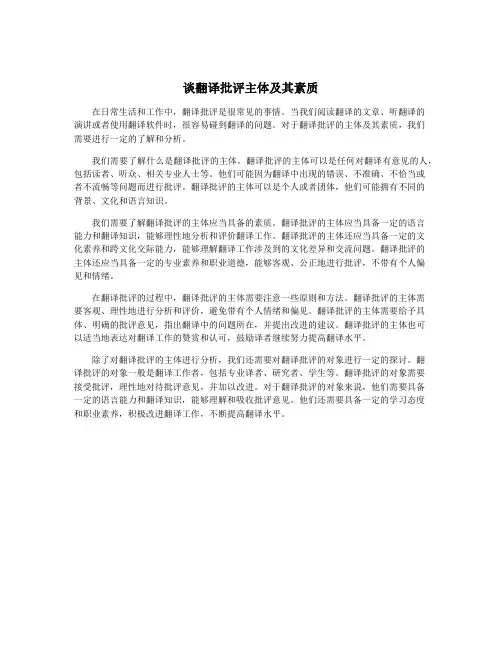
谈翻译批评主体及其素质在日常生活和工作中,翻译批评是很常见的事情。
当我们阅读翻译的文章、听翻译的演讲或者使用翻译软件时,很容易碰到翻译的问题。
对于翻译批评的主体及其素质,我们需要进行一定的了解和分析。
我们需要了解什么是翻译批评的主体。
翻译批评的主体可以是任何对翻译有意见的人,包括读者、听众、相关专业人士等。
他们可能因为翻译中出现的错误、不准确、不恰当或者不流畅等问题而进行批评。
翻译批评的主体可以是个人或者团体,他们可能拥有不同的背景、文化和语言知识。
我们需要了解翻译批评的主体应当具备的素质。
翻译批评的主体应当具备一定的语言能力和翻译知识,能够理性地分析和评价翻译工作。
翻译批评的主体还应当具备一定的文化素养和跨文化交际能力,能够理解翻译工作涉及到的文化差异和交流问题。
翻译批评的主体还应当具备一定的专业素养和职业道德,能够客观、公正地进行批评,不带有个人偏见和情绪。
在翻译批评的过程中,翻译批评的主体需要注意一些原则和方法。
翻译批评的主体需要客观、理性地进行分析和评价,避免带有个人情绪和偏见。
翻译批评的主体需要给予具体、明确的批评意见,指出翻译中的问题所在,并提出改进的建议。
翻译批评的主体也可以适当地表达对翻译工作的赞赏和认可,鼓励译者继续努力提高翻译水平。
除了对翻译批评的主体进行分析,我们还需要对翻译批评的对象进行一定的探讨。
翻译批评的对象一般是翻译工作者,包括专业译者、研究者、学生等。
翻译批评的对象需要接受批评,理性地对待批评意见,并加以改进。
对于翻译批评的对象来说,他们需要具备一定的语言能力和翻译知识,能够理解和吸收批评意见。
他们还需要具备一定的学习态度和职业素养,积极改进翻译工作,不断提高翻译水平。
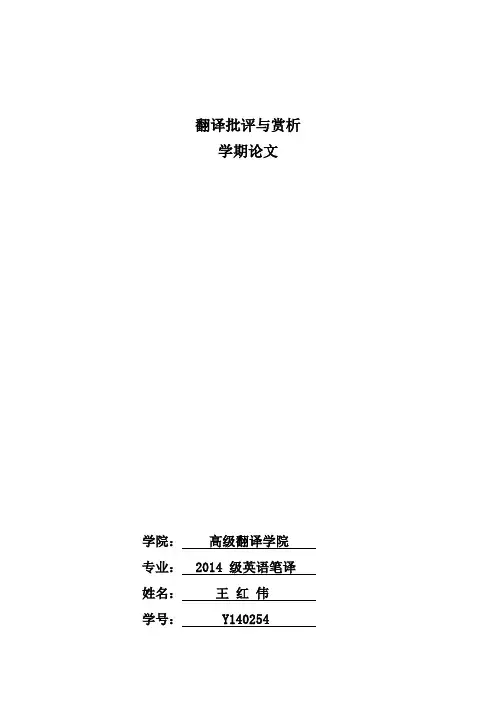
翻译批评与赏析学期论文学院:高级翻译学院专业: 2014 级英语笔译姓名:王红伟学号: Y140254前言学习感悟本学期有幸选了陈老师开设的选修课—翻译批评与赏析,陈老师授课方式新颖独到,以德国功能翻译理论学派重要代表人物凯瑟琳娜·赖斯的《翻译批评:潜力与制约》一书为主线,以学生讲解老师总结答疑为主要方法,并穿插有课堂讨论,让学生各抒己见,畅所欲言,一学期的学习让我收获颇丰。
在未上陈老师的课之前,自己的翻译批评往往多是感性的翻译评论,没有系统的批评理念与批评模式,面对一个译本,只会从表层进行主观评判,既缺乏系统性又不具有客观性,难以服众。
经过一学期的学习我认识到翻译批评绝不是为了批评而批评,更不能带有学术偏见而起意气之争,相互攻讦,翻译批评应该是建设性的,必须公正、客观、全面,有理有据。
作为翻译专业研究生,更应该对翻译批评认真加以学习,用全面的眼光看待翻译,树立科学的翻译批评观,并将其用于指导、审视自己的翻译活动。
翻译批评的文本功能视角—兼评赖斯的文本类型理论摘要:凯瑟琳娜·赖斯是德国功能派翻译理论的主要奠基者,在其扛鼎之作《翻译批评:潜力与制约》中赖斯借鉴德国心理学家布勒的语言功能划分模式将文本划归为三种基本类型:信息型文本、表情型文本和操作型文本,并建议根据文本功能采取相应的翻译方法。
本文从赖斯的文本类型理论着手,结合不同文本译例,并对之加以述评。
关键词:赖斯;翻译批评;文本类型;文本功能;《翻译批评:潜力与制约》1. 引言凯瑟琳娜·赖斯(Katharina Reiss)是德国功能派翻译理论研究的先驱,1971年赖斯出版了其扛鼎之作《翻译批评:潜力与制约》“是德国从语言功能角度切入翻译研究的开端作品”,(陈吉荣,2007:3)赖斯在该书中以文本类型理论为基本框架,试图建构一个客观、可行、全面的翻译批评模式。
赖斯的文本类型理论基本沿用了德国心理学家布勒的语言功能三分法影响,根据布勒的语言功能工具模式,赖斯把文本划分为三种主要类型,即信息型文本、表情型文本和操作型文本(亦称感染型)。
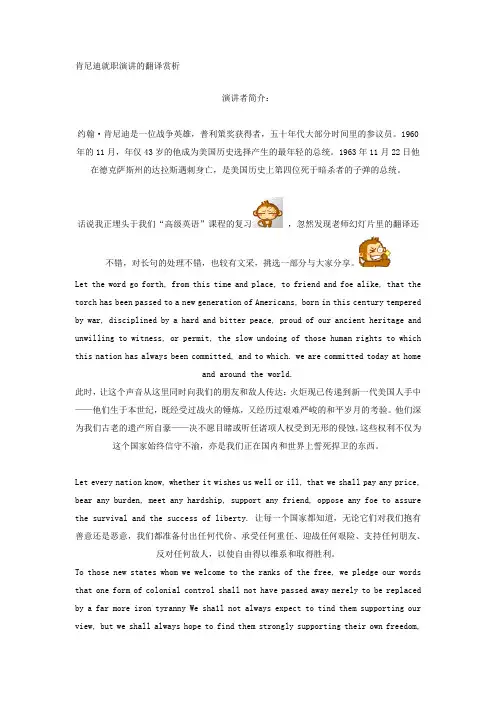
肯尼迪就职演讲的翻译赏析演讲者简介:约翰·肯尼迪是一位战争英雄,普利策奖获得者,五十年代大部分时间里的参议员。
1960年的11月,年仅43岁的他成为美国历史选择产生的最年轻的总统。
1963年11月22日他在德克萨斯州的达拉斯遇刺身亡,是美国历史上第四位死于暗杀者的子弹的总统。
话说我正埋头于我们“高级英语”课程的复习,忽然发现老师幻灯片里的翻译还不错,对长句的处理不错,也较有文采,挑选一部分与大家分享。
Let the word go forth, from this time and place, to friend and foe alike, that the torch has been passed to a new generation of Americans, born in this century tempered by war, disciplined by a hard and bitter peace, proud of our ancient heritage and unwilling to witness, or permit, the slow undoing of those human rights to which this nation has always been committed, and to which. we are committed today at homeand around the world.此时,让这个声音从这里同时向我们的朋友和敌人传达:火炬现已传递到新一代美国人手中——他们生于本世纪,既经受过战火的锤炼,又经历过艰难严峻的和平岁月的考验。
他们深为我们古老的遗产所自豪——决不愿目睹或听任诸项人权受到无形的侵蚀,这些权利不仅为这个国家始终信守不渝,亦是我们正在国内和世界上誓死捍卫的东西。
Let every nation know, whether it wishes us well or ill, that we shall pay any price, bear any burden, meet any hardship, support any friend, oppose any foe to assure the survival and the success of liberty. 让每一个国家都知道,无论它们对我们抱有善意还是恶意,我们都准备付出任何代价、承受任何重任、迎战任何艰险、支持任何朋友、反对任何敌人,以使自由得以维系和取得胜利。
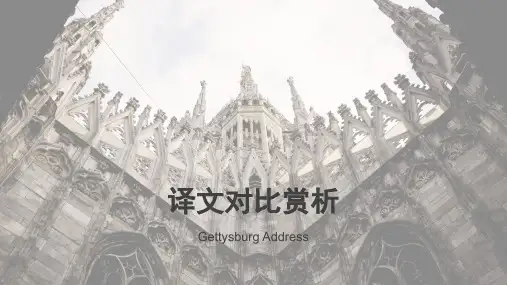
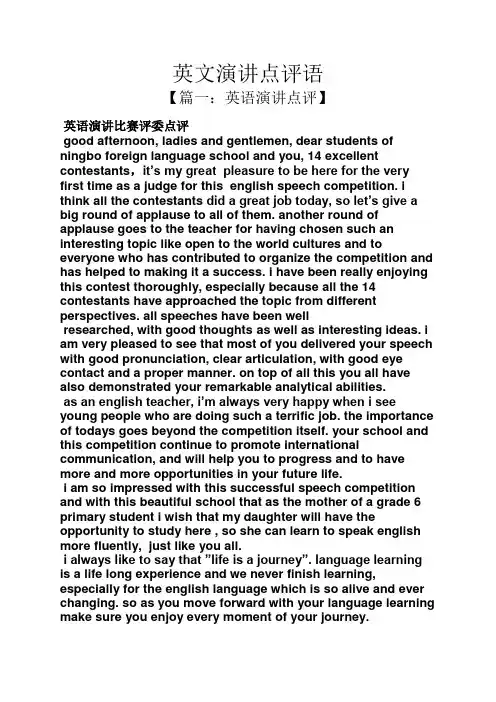
英文演讲点评语【篇一:英语演讲点评】英语演讲比赛评委点评good afternoon, ladies and gentlemen, dear students of ningbo foreign language school and you, 14 excellent contestants,it’s my great pleasure to be here for the veryfirst time as a judge for this english speech competition. i think all the contestants did a great job today, so let’s give a big round of applause to all of them. another round of applause goes to the teacher for having chosen such an interesting topic like open to the world cultures and to everyone who has contributed to organize the competition and has helped to making it a success. i have been really enjoying this contest thoroughly, especially because all the 14 contestants have approached the topic from different perspectives. all speeches have been wellresearched, with good thoughts as well as interesting ideas. i am very pleased to see that most of you delivered your speech with good pronunciation, clear articulation, with good eye contact and a proper manner. on top of all this you all have also demonstrated your remarkable analytical abilities.as an english teacher, i’m always very happy when i see young people who are doing such a terrific job. the importance of todays goes beyond the competition itself. your school and this competition continue to promote international communication, and will help you to progress and to have more and more opportunities in your future life.i am so impressed with this successful speech competition and with this beautiful school that as the mother of a grade 6 primary student i wish that my daughter will have the opportunity to study here , so she can learn to speak english more fluently, just like you all.i always like to say that ”life is a journey”. language learning is a life long experience and we never finish learning, especially for the english language which is so alive and ever changing. so as you move forward with your language learning make sure you enjoy every moment of your journey.finally i would like to take this opportunity to wish all the contestants the best of luck and great success in your future. ---评委老师its terrific to see you dress formally and well prepared for the speech, and your poster is well doneas well.however, you need to make more eye contact with theaudience and better speak with various tones and clear pronunciation. i have to say you are a bit stiff without proper body language, which is no good for impressing the audience and the jury. moreover, i really hope you can put more passion into the speech and try to eich it with more facial expression, then surely your speech would be fabulous.演讲中没有语法错误,尤其其中一个男孩讲的非常好,他演讲的开头很好,而且很幽默,演讲有激情,并且和观众有很好的眼神交流并且在演讲中有适当的肢体语言your grammar is ok. its worth mentioning that a boy gave a fantastic speech with an impressive beginning, furthermore, he was fairly humorous and enthusiastic throughout the speech, and he made good eye contact with the audience and used appropriate body language in the speech.【篇二:演讲点评语】篇一:领导讲话后的评语恰到好处,深入关键,认清形势,为我们今后的发展指明了方向。
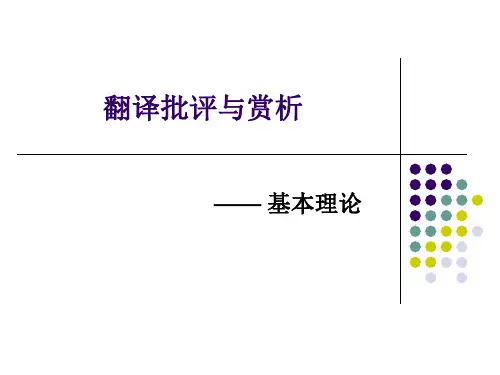

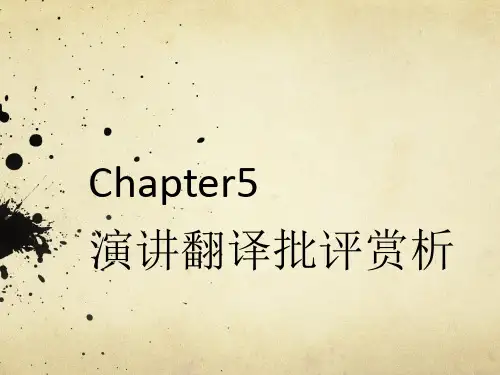
翻译批评与鉴赏-范文译者的阐释与读者的误读:以《红楼梦》译文为例作者(学号)(学院、班级、专业)摘要:文学经典的阐释是一个历史过程,永远不会终结。
译者翻译的过程,是对原文文本进行阐释的过程。
读者阅读的过程,也是对译文文本进行阐释的过程。
但是,在批评界,阐释、误读与错译三者有时混为一谈,甚至等同起来。
阐释学观点认为,对作品的理解总是以理解者——包括作者、译者、读者——的视野为前提。
本文通过讨论《红楼梦》中几个具体例证,试图考察作者、译者、读者三个主体因素在文本的创作、翻译和阅读过程中所起的主体作用。
本文指出,译者对原文的不同解读,在读者眼里可能是错译,也可能是误读——在理解者本人看来,不同于自己理解的就是误读。
这些解读,无论是合理的还是不合理的,都构成文学文化的一部分。
(宋体,小五,1.25倍行距)关键词:译者;错译;误读;阐释学;主观性Translator’s Interpretation and/or Readers’ Misinterpretation: A Case Study of the Renditions of Honglou MengAuthor Name (student number)Abstract: Interpretations of literary classics is a historical process without end. The process of translating ST and reading TT is a process of interpretation. Translation errors and misinterpretations are sometimes confused and misused by the critics. Cultural misinterpretation is a complex phenomenon in literary translation, with multifarious reasons. From a hermeneutic point of view, interpretation is always conditioned by one’s own horizons and perspective. By discussing several exemplary cases of Honglou Meng in translation and cross-cultural understanding, this paper argues that the author, translator and reader can all play a subjunctive role in their respective interpretation processes of writing, translating and reading. Translation errors should be avoided, while misinterpretations, whether reasonable or unreasonable, are unavoidable and destined to be part of literature. (Times New Roman, 5号, 1.25倍行距)Key Words: translation errors; misinterpretation; author; translator; reader一、引言(小标题用黑体五号字;正文用宋体五号字)“文化”一直是经久不衰的话题。
林肯《葛底斯堡演讲》汉译文的对比分析摘要:林肯的《葛底斯堡演讲》是历史上著名的演讲名篇,多年来我国许多人都曾尝试翻译此篇演讲词。
本文将以张培基《英汉翻译教程》里刊载的演讲词翻译以及许渊冲《翻译通讯》里刊载的演讲词翻译为主,对这两篇译文进行浅略分析,谈谈笔者对这两篇译文的看法。
关键词:林肯《葛底斯堡演讲》汉译文;张培基《英汉翻译教程》;许渊冲《翻译通讯》一、原文分析1863年11月19日,林肯在宾夕法尼亚州葛底斯堡的葛底斯堡国家公墓揭幕式中发表此次演说,哀悼在长达五个半月的葛底斯堡之役中阵亡的将士。
林肯《葛底斯堡演讲》全文总共10个句子,267词,演说时间只有两分钟。
本文同属表达型文本和呼唤型文本。
文章没有任何多余的赘言,开门见山,立即转入正题;结尾语气坚定,给听众留下感情奔放、情意深切、逻辑严密和生动有力的深刻印象。
二、译文比较分析1、词汇选择原文1:Fourscore and seven years ago ... a new nation, conceived in Liberty, and dedicated to the proposition that all men are created equal.张译:七八十年以前,我们的先辈们在这个大路上创立了一个新国家,它孕育于自由之中,奉行一切人生来平等的原则。
许译:七八十年前,我们的先辈们在这个大陆上建立了一个以自由为理想、以人人平等为宗旨的新国家。
文中conceived 和dedicated 两个动词的含义对于表现这个国家的自由平等有重要的作用。
张分别使用“孕育”、“奉行”两个动词来体现;许则简化了这两个词,以“神似”的意译来取代了直译,“一个以自由为理想、以人人平等为宗旨的新国家”。
笔者认为,翻译中所表达的原文含义比翻译中所采用的结构更为重要,许的简化翻译使得译文丢失了部分原文的内容。
原文2:But, in a larger sense,we cannot dedicated―― we cannot consecrate――we cannot hallow――this ground.张译:但是,从更广泛的意义上来说,这块土地我们不能够奉献,我们不能够圣化,我们不能够神化。
讲话致辞翻译分析
讲话致辞的翻译分析是指对讲话致辞进行翻译时的分析过程和方法。
翻译这类文本需要考虑到讲话的目的、风格、语言特色等因素,以保持原文的真实性和表达效果。
翻译讲话致辞时,首先要了解原文的整体结构和内容,包括讲话的主题、目标受众、主要论点等。
这有助于理解讲话的整体思路和逻辑关系。
同时,要注意原文讲话的风格和语言特色。
有些讲话可能是正式的、庄重的,而有些可能是亲切的、口语化的。
翻译时要根据原文的语气和风格选择合适的译文表达方式,使其能够传达相同的情感和效果。
此外,还需注意讲话中的修辞手法和修辞效果。
讲话致辞通常包含一些修辞手法,如夸张、比喻、排比等,这些手法对表达情感、增强说服力起到重要作用。
翻译时要尽量保留原文中的修辞手法和效果,使译文与原文具有相似的修辞效果。
在进行具体翻译时,应结合上述分析,灵活运用翻译技巧和方法。
例如,可以选择逐字翻译、意译、调整语序等方式来保持原文信息的完整性和表达的准确性。
总之,翻译讲话致辞需要综合考虑文本内容、风格和修辞特点等方面,并结合适当的翻译技巧和策略,以保证译文的准确性和流畅性,同时保持原文讲话的表达效果。
《在诺贝尔奖颁奖典礼上的演讲》译文英汉对比评析威廉·福克纳(William Faulkner 1897年9月25日-1962年7月6日),美国文学史上最具影响力的作家之一,意识流文学在美国的代表人物,1949年诺贝尔文学奖得主,获奖原因为“因为他对当代美国小说做出了强有力的和艺术上无与伦比的贡献”。
他一生共写了19部长篇小说与120多篇短篇小说,其中15部长篇与绝大多数短篇的故事都发生在约克纳帕塔法县,称为“约克纳帕塔法世系”。
其主要脉络是这个县杰弗生镇及其郊区的属于不同社会阶层的若干个家族的几代人的故事,时间从1800年起直到第二次世界大战以后。
世系中共600多个有名有姓的人物在各个长篇、短篇小说中穿插交替出现。
最有代表性的作品是《喧哗与骚动》。
本文讨论的是威廉伯克纳在诺贝尔奖颁奖典礼上的演讲一个译文,关于威廉伯克纳在颁奖典礼上的演讲,正值威廉伯克纳一生事业的巅峰,做出了这一篇法人深省的演讲词,对其演讲词的翻译国内已经有了好几个不同的版本。
通过与原文的对比,做出简要评析。
一·I feel that this award was not made to me as a man, but to my work -- a life’s work in the agony and sweat of the human spirit, not for glory and least of all for profit, but to create out of 1.the materials of the human spirit something which did not exist before. So this award is only mine in trust.2. It will not be difficult to find a dedication for the money part of it commensurate with the purpose and significance of its origin.3. But I would like to do the same with the acclaim too, by using this moment as a pinnacle from which I might be listened to by the young men and women already dedicated to the same anguish and travail, among whom is already that one who will some day stand here where I am standing.1. 其中在‘the materials of the human spirit’这点文章翻译为人类精神原材料,而我则有不同观点。
翻译批评与赏析翻译的作品既有批评也有赏析的一面。
批评在评价作品的同时也反映了翻译者对作品的不满之处,赏析则探讨了作品的亮点和其独特的价值。
批评的部分通常集中在作品的翻译质量、表达准确性以及语言的流畅性等方面。
翻译是一项复杂的任务,需要翻译者准确地传达原文的意思,同时还要确保译文在目标语言中的流畅度和可读性。
因此,如果翻译者的译文与原文相比存在明显的错误、不通顺或难以理解的地方,就很可能会受到批评。
对于这些问题,批评文章可能会针对具体的例子进行拆解和讨论,并指出翻译者应该如何改进。
然而,翻译的批评并不仅仅局限于指出问题所在。
批评文章也会探讨翻译作品所面临的挑战以及困难,并分析导致问题的原因。
这种批评不仅为读者提供了对翻译工作的更深刻理解,也可以为翻译者提供改进自己工作的方向和建议。
与批评不同,赏析部分则着重于翻译作品的价值和亮点。
赏析可能从翻译作品的创新性、表达方式、传达感情的能力以及对原著的忠实度等方面进行分析和评价。
赏析不仅关注翻译作品自身的价值,还可以探讨其对文化传播和对读者的影响。
翻译的批评与赏析在一定程度上相互依存。
没有批评的话,赏析可能会变得肤浅,只满足于简单陈述某些翻译作品的好处。
而批评则可以通过指出问题所在,引发深入的讨论和批判性思考,并促使翻译者和读者对翻译作品有更全面的理解。
赏析则可以为翻译者提供积极的反馈和支持,提高他们的工作动力和翻译质量。
总之,翻译的批评与赏析一起构成了翻译作品评价的完整体系。
批评提供了指导和改进的建议,而赏析则赞赏和强调翻译作品的价值。
通过批评与赏析的结合,可以更全面地理解和评价翻译作品,并提高翻译的质量和价值。